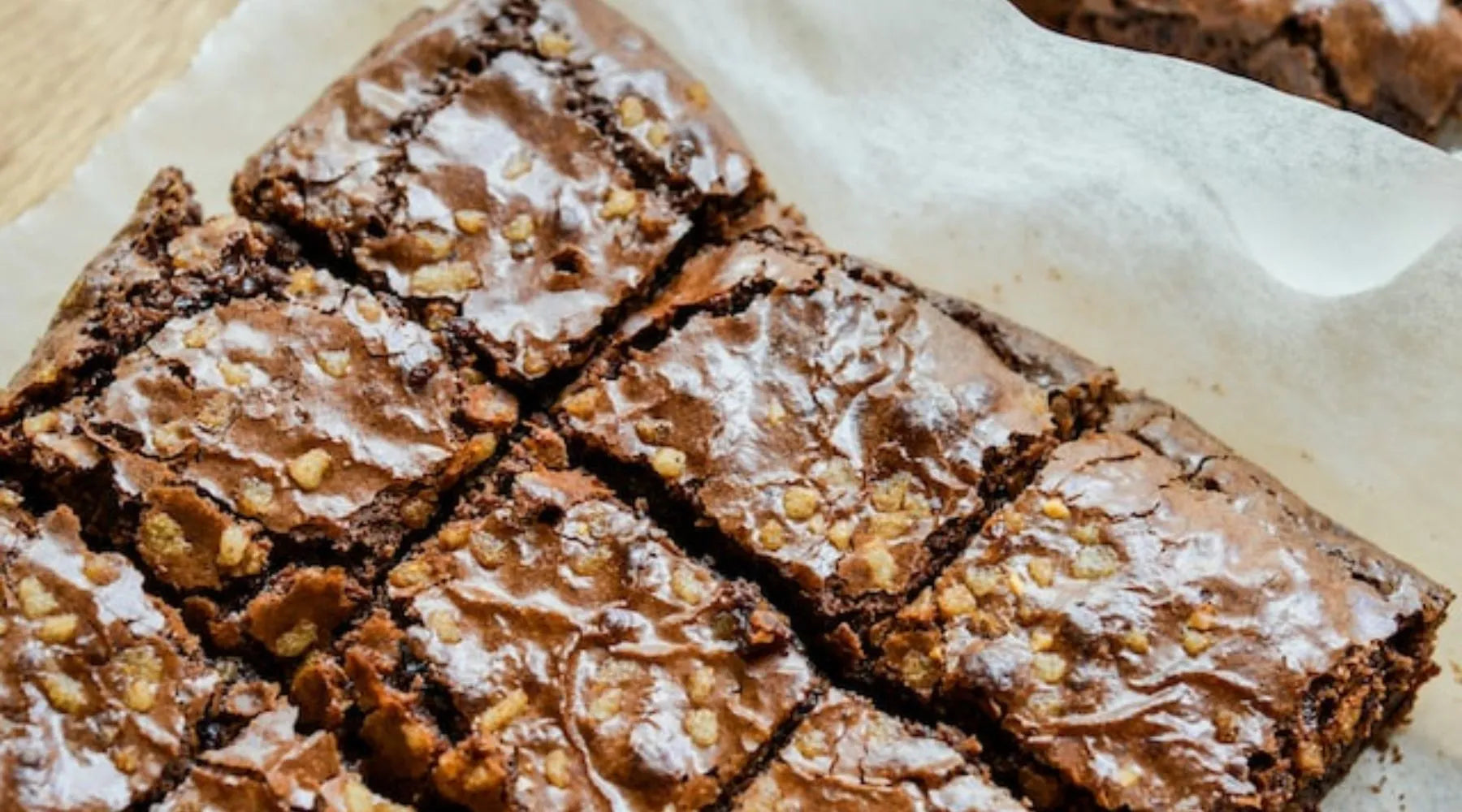When buying conventional cocoa powder, you may have noticed that a distinction is made between high- and low-oil cocoa powder. And if you've spent more time researching cacao, the terms "alkalized cacao" or "Dutch processed cacao" may have caught your eye. Many stumble across these categories and cannot do much with them. Here we explain what differentiates the cocoa powders mentioned, what Holland has to do with it and which cocoa is best suited for baking or preparing your cocoa.
There are only two types of cocoa powder available in most supermarkets and drugstores: low-fat and low-fat. This distinction lies in the production process of the cocoa: after the cocoa beans have been harvested and fermented, they are roasted, separated from the shell and the surrounding pulp and finally ground, resulting in a relatively fatty cocoa mass. Depending on how much cocoa butter is drained from this cocoa mass, the remaining "cocoa press cake" can be further processed into heavily or slightly de-oiled cocoa powder.
When deciding which cocoa to buy, the decisive factor is what you want to use it for: low-fat cocoa is more easily soluble and has a milder taste, making it ideal for the preparation of cocoa drinks, while low-fat cocoa has a rather strong taste and so better used for baking chocolatey treats.
As already mentioned, you can only choose between these two types of cocoa in most conventional shops.
However, should you ever come across alkalized cocoa or cocoa advertised as "Dutch Processed Cocoa", this means that an additional step has been added to cocoa production, the so-called alkalization.

Perhaps the term “alkalization” or “alkaline solution” still sounds familiar to you from chemistry class? Alkalizing describes the process of changing the pH value towards a higher (between 7 and 14) and therefore alkaline value. For everyone who often fell asleep in chemistry class. ;-) The pH value of solutions or foods can vary, in general a distinction is made between acidic and basic, so-called "alkaline" foods. Non-alkalinized conventional cocoa has a rather low, i.e. very acidic value, which is why some manufacturers include the intermediate step of alkalinization in cocoa production:
During the production of alkalized cocoa, alkali salts, such as potassium carbonate or sodium carbonate, also known as "potash" or household soda, are added to the cocoa nibs or cocoa mass to reduce the acid content. These added alkaline salts lower the free acid content in the cocoa by binding it to itself and the pH value is increased as if by magic - or just this chemical reaction. In order to guarantee a safe cocoa experience without added chemicals and foreign tastes, the acidified salts are then filtered out again through sedimentation.
In fact, the name of Dutch cocoa or "Dutch Processed Cocoa" simply describes that the cocoa powder has gone through the additional step of alkalizing. This fact is attributed to the inventor of this additional production step of cocoa, the Dutchman Coenraad van Houten , who first came up with the idea of incorporating this step into cocoa production.


If you are looking for the perfect baking cocoa and can only decide based on the fat content, you should use low-fat cocoa. When considering whether to use alkalized or non-alkalized natural cacao for baking, it's best to refer to the specific recipe. Ultimately, however, it is a matter of personal taste, you should just not combine alkalized cocoa powder with baking soda, as described above. For experienced chocolate cake bakers: In this blog post, Serious Eats compared the two types of cocoa in a baking experiment, including photos and descriptions of consistency, fluffiness and taste!
For the perfect drinking cocoa experience, the highly de-oiled variant is best with regard to the two basic cocoa distinctions. Whether you use alkalized or non-alkalined cocoa here depends on your personal taste. The quality of the unalkalized cocoa also plays a major role. Similar to good chocolate made from fine flavor cocoa, there are also fine cocoa varieties, such as Arriba Nacional Cacao, which can taste very mild and full-bodied even without alkalinization. Incidentally , real chocolate is also ideal for preparing real drinking chocolate! Here you will find some great recipes: for example for hot chocolate with a (special) shot or vegan hot chocolate with dates . And – for slightly summery temperatures – a drinking chocolate with Earl Gray and strawberries or an iced chocolate with cocoa nibs and cream topping .
In general, however, what you like is allowed! Chocolate lovers who are keen to experiment can of course also try them out individually 😊
Has this text aroused your curiosity and willingness to experiment with alkalized, "Dutch processed" cocoa? Don't worry, even if the search for it can take a little longer, you don't have to travel to our magical neighboring country! You can find alkalized cocoa either in well-stocked organic shops or in various online shops. Do you want a milder, natural cocoa for your drinking chocolate? Then we can recommend the Arriba Nacional Cacao variety mentioned above. We plan to offer them in our online shop soon. So you are only a few clicks away from the perfect cocoa experience 😉.
Conventional cocoa powder
There are only two types of cocoa powder available in most supermarkets and drugstores: low-fat and low-fat. This distinction lies in the production process of the cocoa: after the cocoa beans have been harvested and fermented, they are roasted, separated from the shell and the surrounding pulp and finally ground, resulting in a relatively fatty cocoa mass. Depending on how much cocoa butter is drained from this cocoa mass, the remaining "cocoa press cake" can be further processed into heavily or slightly de-oiled cocoa powder.
So: do you prefer to buy low-fat or low-fat cocoa?
When deciding which cocoa to buy, the decisive factor is what you want to use it for: low-fat cocoa is more easily soluble and has a milder taste, making it ideal for the preparation of cocoa drinks, while low-fat cocoa has a rather strong taste and so better used for baking chocolatey treats.As already mentioned, you can only choose between these two types of cocoa in most conventional shops.
However, should you ever come across alkalized cocoa or cocoa advertised as "Dutch Processed Cocoa", this means that an additional step has been added to cocoa production, the so-called alkalization.

Plain text: what exactly is alkalized cocoa?
Perhaps the term “alkalization” or “alkaline solution” still sounds familiar to you from chemistry class? Alkalizing describes the process of changing the pH value towards a higher (between 7 and 14) and therefore alkaline value. For everyone who often fell asleep in chemistry class. ;-) The pH value of solutions or foods can vary, in general a distinction is made between acidic and basic, so-called "alkaline" foods. Non-alkalinized conventional cocoa has a rather low, i.e. very acidic value, which is why some manufacturers include the intermediate step of alkalinization in cocoa production: During the production of alkalized cocoa, alkali salts, such as potassium carbonate or sodium carbonate, also known as "potash" or household soda, are added to the cocoa nibs or cocoa mass to reduce the acid content. These added alkaline salts lower the free acid content in the cocoa by binding it to itself and the pH value is increased as if by magic - or just this chemical reaction. In order to guarantee a safe cocoa experience without added chemicals and foreign tastes, the acidified salts are then filtered out again through sedimentation.
Is alkalized cocoa the same as Dutch cocoa or Dutch Processed Cocoa?
In fact, the name of Dutch cocoa or "Dutch Processed Cocoa" simply describes that the cocoa powder has gone through the additional step of alkalizing. This fact is attributed to the inventor of this additional production step of cocoa, the Dutchman Coenraad van Houten , who first came up with the idea of incorporating this step into cocoa production. 
So how does alkalized cocoa stand out?
- Alkalized cocoa is less acidic and tastes much milder than conventional cocoa
- Due to the lower pH value, alkalized cocoa is more easily soluble, making it more suitable for cocoa preparation than conventional cocoa varieties.
- Dutch Processed Cocoa is also better tolerated than conventional, non-alkalized and therefore sour cocoa. Like all acidic foods in general, this can easily trigger heartburn in people with sensitive stomachs.
- The color of alkalized cocoa is significantly deeper than non-alkalinized cocoa. That is why it is also popular in the production of many conventional chocolate sweets such as Oreo cookies.
- Would you like another chemistry excursion and important information for all passionate chocolate cake bakers among you? Alkalized cocoa should not be mixed with baking soda because there can be no reaction due to the lack of acid! So: better mix alkalized cocoa with baking powder when baking 😊
In comparison, natural, unalkalized cocoa powder is…
- More sour and bitter, i.e. simply tart in taste than alkaline, which only applies to conventional cocoa powder. Because fine cocoa powder can taste very mild, just like chocolate made from fine flavor cocoa, depending on the type of bean
- In addition, unalkalinized cocoa contains more of its original valuable antioxidants and important minerals such as magnesium, phosphorus, potassium, iron and zinc, which are lost in the alkalinization process. It is also healthier than alkalized cocoa!
- One final chemical connection in this text: Unlike alkalized cocoa, natural cocoa powder is safe to use with baking soda. It contains more natural acid, so nothing stands in the way of perfect fluffiness in combination with soda!

In a nutshell: when which cocoa powder?
If you are looking for the perfect baking cocoa and can only decide based on the fat content, you should use low-fat cocoa. When considering whether to use alkalized or non-alkalized natural cacao for baking, it's best to refer to the specific recipe. Ultimately, however, it is a matter of personal taste, you should just not combine alkalized cocoa powder with baking soda, as described above. For experienced chocolate cake bakers: In this blog post, Serious Eats compared the two types of cocoa in a baking experiment, including photos and descriptions of consistency, fluffiness and taste! For the perfect drinking cocoa experience, the highly de-oiled variant is best with regard to the two basic cocoa distinctions. Whether you use alkalized or non-alkalined cocoa here depends on your personal taste. The quality of the unalkalized cocoa also plays a major role. Similar to good chocolate made from fine flavor cocoa, there are also fine cocoa varieties, such as Arriba Nacional Cacao, which can taste very mild and full-bodied even without alkalinization. Incidentally , real chocolate is also ideal for preparing real drinking chocolate! Here you will find some great recipes: for example for hot chocolate with a (special) shot or vegan hot chocolate with dates . And – for slightly summery temperatures – a drinking chocolate with Earl Gray and strawberries or an iced chocolate with cocoa nibs and cream topping .
In general, however, what you like is allowed! Chocolate lovers who are keen to experiment can of course also try them out individually 😊



